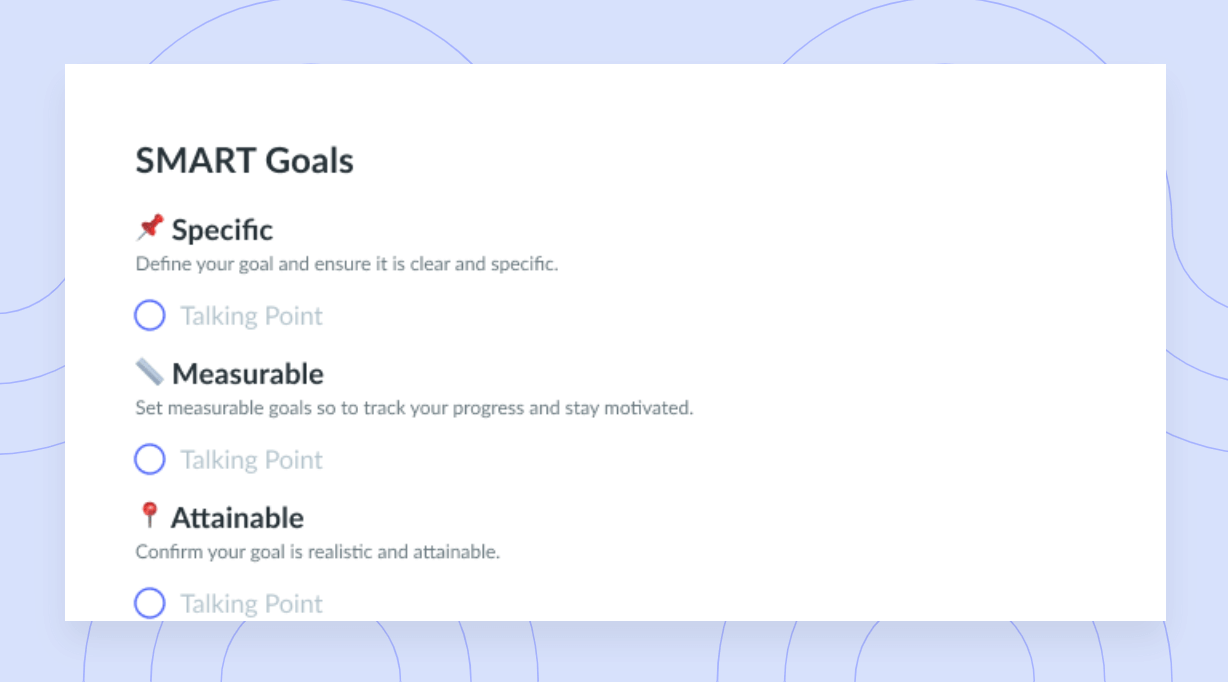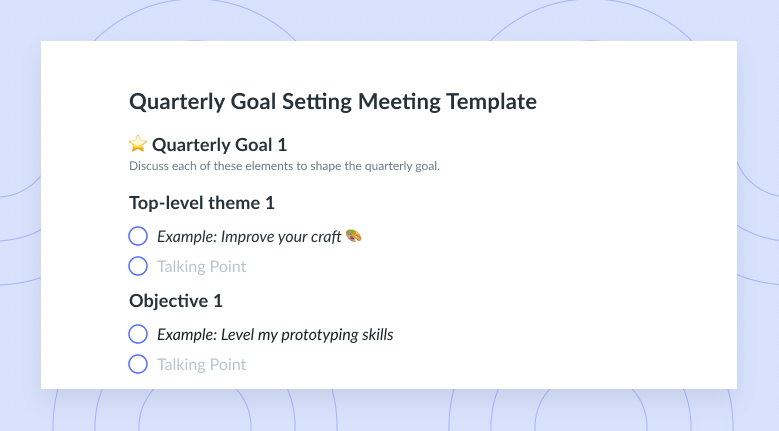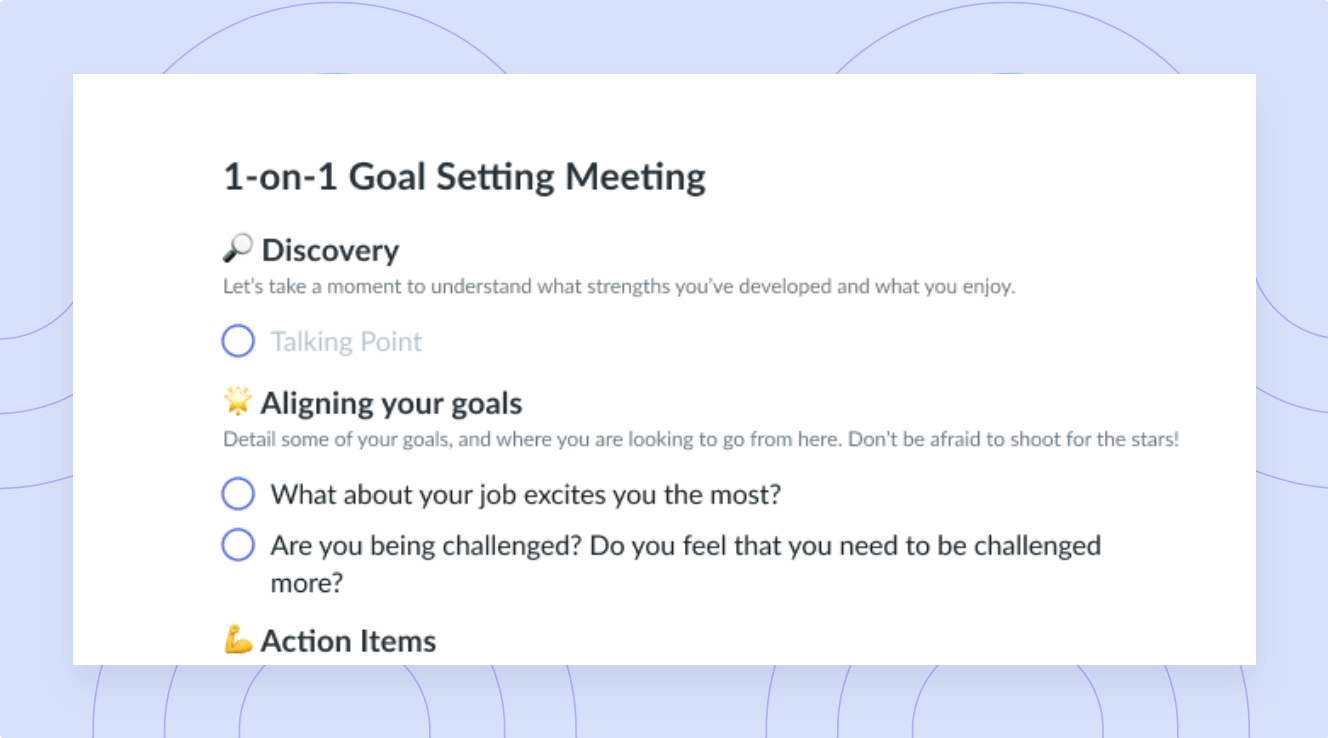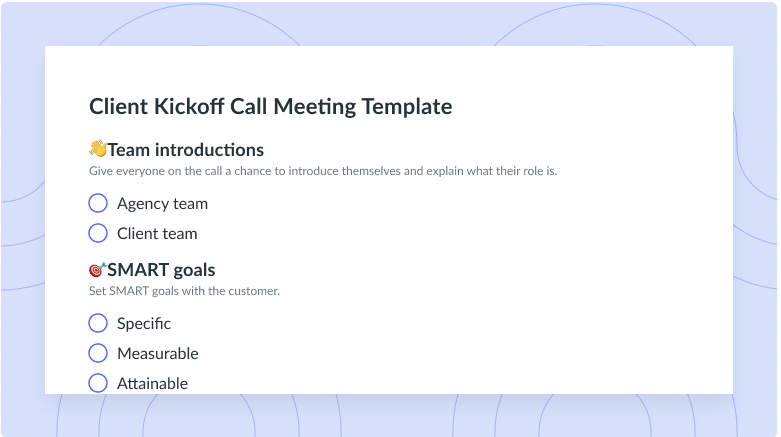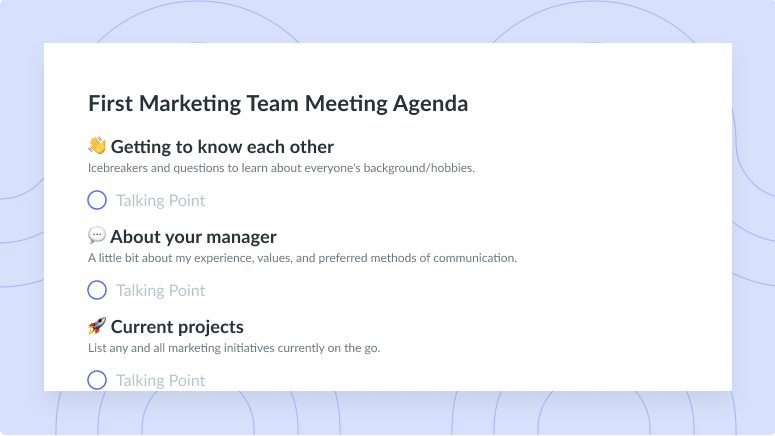Team Goals: How to Align, Motivate, and Drive Your Team Forward
Setting team goals helps get everyone on the same page and moving forward, and you can change them as needed.
Nobody can do anything alone, and that’s true both in your personal life and at work. After all, you’re leading a team—your work is, by its very nature, a collaboration. It’s also a collaboration that goes much better when you have clear team goals in place.
Team goals get your team on the same page and power them onward, and you can change your goals if your team feels that’s best. Below, learn what team goals are, why they matter, and how to set and adjust them, and leverage our team goals examples as well!
- Definition of team goals
- The importance of team goals
- How to set team goals
- Help your team achieve goals
- 6 team goals examples
Definition of team goals
Team goals are milestones or performance benchmarks that your team members set together. These goals build your organization’s business strategies while furthering its mission and vision statements, and they often guide your team toward achieving certain metrics by a set deadline or developing new skills.
Another core purpose of team goals is to engage your team members. When people work toward benchmarks they’ve helped set, they’re more likely to feel motivated to achieve them.

Simplify team goal-setting
Fellow seamlessly integrates objectives and key results into everyone’s meetings so they’re always top of mind, trackable, and part of discussions and decisions.
The importance of team goals
Team goals matter because they:
- Guide your team toward clear target outcomes.
- Drive team-wide accountability, ownership, transparency, trust, and collaboration.
- Set key performance indicators (KPIs) that indicate success and guide performance reviews.
- Surface neglected tasks or action items.
- Show how your team’s work furthers your organization’s mission.
- Help team members see how their tasks play into the group’s objectives.
- Lay out paths for team members to grow or develop professionally.
- Boost employee engagement and satisfaction.
How to set team goals
Team goal setting is a hassle-free process when you take these eight steps.
- Identify the team objectives
- Explain the why
- Involve the entire team
- Use SMART goals
- Prioritize based on impact
- Create an action plan
- Define clear metrics
- Hold meetings regularly
1Identify the team objectives
Achieving team objectives starts with knowing what you want to accomplish after all is said and done. Gather your team to ask and answer: What goals do we have in mind and why? How does our organization benefit from these goals being achieved? What short-term and long-term organizational objectives do these goals serve? Which team performance metrics will we use to track our progress? Your answers can help you start to fine-tune your team goals.
2Explain the why
Getting your team’s buy-in on your goals is a great first step. After that comes getting the green light from the groups your organization serves: customers, clients, and other stakeholders. To get these folks on board, reframe your goals meaningfully for both them and your team. Show how and why the actions and outcomes you have in mind bring value to the people who pay and fund your organization.
3Involve the entire team
It’s in the name: These are team goals. As such, if you get your team’s input on your goals at every step, you’re off to a great start. You’re really doing it right, though, if you set challenging yet realistic team goals.
Since you’re involving a group of people in your goals, you have space to be ambitious. If anything, breaking team goals into more digestible individual goals often shows that your highest aims are within reach. Put another way, team collaboration and goals go hand in hand.
4Use SMART goals
Maybe you’ve heard this one before: All types of goals—team, individual, project—should be SMART goals. Effective goals are specific, measurable, achievable, relevant, and time-bound.
You and your team should ask and answer the following questions to properly build out a SMART goal:
- How can we make our goal as clear and direct as possible?
- What numerical outcome are we working toward?
- Do we have the resources necessary to achieve this goal, and if not, how can we obtain them?
- How does this goal serve our organization, clients, customers, or stakeholders?
- By when, or over what period, will we achieve this goal?
5Prioritize based on impact
Motivation and team goals are powerful partners when you prioritize goals that affect your organization and people. Put goals that guide your team toward making your clients happy near the top of your list. Rank these just under goals that change your processes in ways that drive employee satisfaction.
Think about it like this: Many goals have ripple effects. Your goal to improve work-life balance, for example, can give your team members the better mental health they need to do their best work. That’s good for your organization, your clients or customers, your stakeholders, and everyone in between. In other words, it’s the goal you should put at the top of your list.
6Create an action plan
Your action plan is one of your biggest assets in overcoming team goal challenges. It’s how you take your loosely defined idea of a goal and turn it into an ordered list of relevant tasks. To create your plan, put your team goal into writing in your note-taking platform—doing so can make you more likely to achieve your goal. Then, note some milestones in this platform and line them up with your goal. You now have a clear order of milestones to work through.
Your next step is to create paths between milestones. That’s where team tasks come into play. Delegate these tasks to your team members, keeping task dependencies in mind. You now have an ordered list of tasks—also known as an action plan—that gets you to the finish line.
7Define clear metrics
Teamwork and goal management go much more smoothly when you use the SMART method, the hardest part of which might be setting metrics. You may wonder: What exactly do you measure, and how? Here are some ways to land on clear metrics and agree on how you’ll track them:
- Set up software and team check-ins for tracking and adjusting goals.
- Provide the appropriate team members with access to data that shows your previous achievements and how much further you can go.
- Assign someone the ongoing task of tracking each relevant metric.
- Regularly create progress reports and adjust your goals accordingly.
8Hold meetings regularly
Sometimes, the fastest way to check your goal progress isn’t through data but through direct input from your team. Hold recurring meetings with your team during your goal’s lifetime to get their feedback. Set this recurring meeting’s end date to align with the goal’s deadline, thus reinforcing the time frame. Between your clear endpoint and the continuous feedback on whether your goal remains feasible, goal alignment in teams is all but guaranteed.
A tool like Fellow can ensure these regular meetings stay high-value, productive, and mindful with meeting best practices integrated into every calendar event.
Help your team achieve goals
Here are four easy ways to help everyone achieve your team goals.
- Offer everyone autonomy to develop their own goals
- Use deadlines to ensure accountability
- Track progress
- Keep yourself available
1Offer everyone autonomy to develop their own goals
By team goals’ very nature, they’ll get broken down into smaller tasks and goals for individual team members. That’s why you should give your team members the room to set their own corresponding goals. Push them to go beyond their usual limits but not unrealistically far, and ensure their goals serve the overall team goal, too.
2Use deadlines to ensure accountability
When you set deadlines, you make your standards known, and team members who fail to meet them can apologize and explain their next steps. That’s the essence of building accountability in the workplace.
3Track progress
It’s on you to pave new paths forward when your team falls behind, or you can reset your expectations to be more realistic. If your team is instead ahead of schedule, you could aim for more ambitious goals. In either case, you need to track progress to know the direction in which you’re headed. You can use Fellow’s objectives and key results (OKRs) feature to easily set and track measurable team goals and review them during meetings.
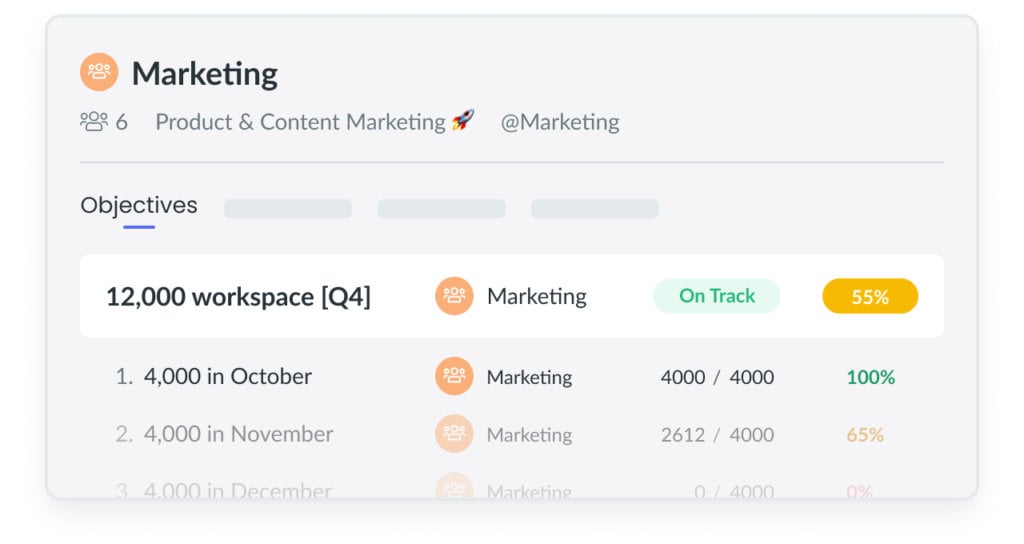
4Keep yourself available
Success is more likely when you take the journey with your team rather than removing yourself once you’ve set goals. Instead of just being the person who sets goals, delegate some of the required tasks to yourself. Keeping yourself available in this way can help you get where you’re going—and it’s not the only way you should make yourself available. Remain reachable for and open to your team’s feedback and change requests at any time to ensure your goals remain achievable and relevant.
6 team goals examples
If you’re on leadership, sales, marketing, customer success, engineering, or design teams, these team goals examples are for you. All of them are specific, measurable, achievable, relevant, and time-bound.
- Leadership: Within the next month, collaborate on and implement a time-off policy that gives team members two additional personal days a month.
- Sales: During Q1, increase sales call volume by 5% to increase sales revenue from our third-best-selling product by 10%.
- Marketing: Publish 15 1,000-word blog posts this quarter to increase website traffic by 15%.
- Customer success: Survey 100 customers to get ideas for customer service changes. Implement the three most commonly shared ideas over the next year to increase our Google Reviews rating by 0.5 stars.
- Engineering: Write 75% of our full code for version 2.0 of our app within the next six months.
- Design: Develop 50% of the web pages for our client’s new website within the next two months, with at most five links that need fixing.
Parting advice
Team goals reverberate far beyond the people you work with and lead. When your team does better, so does your organization, leaving your customers and clients happier. Plus, as you set increasingly ambitious goals and keep pulling them off, you’ll get more customers interested in your services. That’s a boon for your stakeholders, who will certainly be happy to see this growth. Use Fellow to hold team meetings, set and track OKRs, and assign and track action items that get you over the finish line!

![How to Set Productivity Goals for 2024 [+ Examples]](https://fellow.app/wp-content/uploads/2023/12/productivity-goals-2.jpg)








